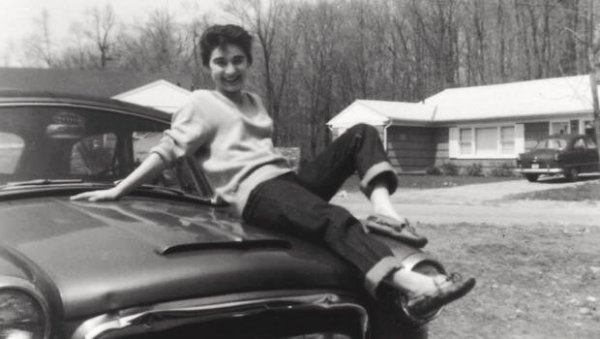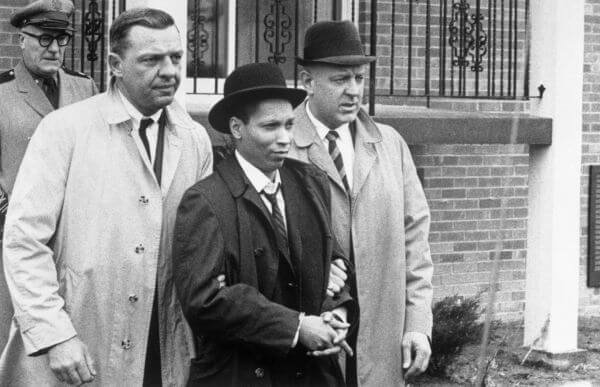Kitty Genovese, the Girl who Screamed and Nobody Helped


Written and verified by the psychologist Valeria Sabater
But there’s even more horror. The scene is just full of darkest side of humanity. They say that finally one man did open his window and yelled, “Leave that girl alone!” The attacker, Winston Moseley, moved away from her for a few minutes. Kitty got up, badly wounded, and went into the entryway of a nearby building.
No one helped her. The people who saw her thought it was nothing, no big deal. But, Moseley didn’t take long to find her again so he could attack her and end her life. Days later all of New York held its breath when the New York Times published a series of long articles where they bluntly exposed the apathy, the silence, and the inhumanity.
The articles were almost like a psychological autopsy of a society shirking its responsibilities. One that decides not to act, to look the other way, and hide. Ignoring any cries for help.
The Kitty Genovese case changed a lot of people’s ideology, and contributed to new theories in the field of psychology. Let’s take a look.

Kitty Genovese and a Society’s Reflection
Winston Moseley was an engineer by profession, married with three kids. When he was arrested for a robbery, he didn’t take long to confess to the murder of Kitty Genovese and two other young people.
The psychiatrists would conclude later on that he suffered from necrophilia. Last year, he died in prison at 81 years old, after committing violent assaults in those same prisons and mental wards.
Kitty’s attacker served his sentence while she remained forever in our collective ideology as the girl who no one helped. As the women who died in front of 38 witnesses that did not react.
That’s how the media explained it. And that’s how it was publicized in the well-known book, “Thirty-Eight Witnesses: The Kitty Genovese Case,” by A.M. Rosenthal, the editor of the New York Times in that era.
Now then, we should mention that according to a study published in 2007 in the magazine, American Psychologist, the story of Kitty Genovese’s murder was slightly exaggerated by the media.
In fact, in the 2015 documentary, “The Witness,” we can see the fight undertaken by Kitty’s brother to try to find out what really happened.
The conclusion is as simple as it is devastating. No one could actually see what was happening, and the people who called the police were ignored because none of them could clearly explain what was going on.

The Genovese Effect, or “The Theory of Diffusion of Responsibility”
In any case, this event helped psychologists formulate the well-known “Theory of Diffusion of Responsibility.” Because in reality, if we really think about it, it doesn’t matter whether people did or didn’t see the attack on Kitty Genovese. Or whether they did or didn’t call the police. It also doesn’t matter if there were 12, 20, or 38 witnesses, as they explained in the New York Times.
The main question is with the fact that no one paid attention to her screams. For 30 minutes no one came outside or went to the entryway where a man was attacking a young woman.
The psychologists John Darley and Bibb Latané explained this behavior under the theory of “diffusion of responsibility.” In it, they show us how the more spectators there are, the less likely it is any one of them will actually help.
When someone needs help, the spectators assume someone else will step in. Someone else will “do something.” But, the outcome of this individual way of thinking is that in the end none of the spectators will bother to step in. And the responsibility will end up spreading thin among the whole group.
This means no one will take responsibility. This is also something we can see with requests. It’s much better to say, “Peter, would you please turn on the light,” than “Will someone please turn on the light.” In the first case, by choosing someone we specifically prevent that diffusion of responsibility.
Factors in diffusion of responsibility
Finally, we want to point out that in the diffusion of responsibility, there are other important factors that come into play when it comes to offering help or assistance:
- If the person more or less identifies with the victim. A higher feeling of identification creates less diffusion of responsibility.
- If stepping in might have some personal cost. In Kitty’s case, with the fear of also being attacked, the odds of diffusion of responsibility will go up.
- If the person thinks they’re in a better or worse position to help compared to the rest of the group. For example, a self-defense expert will feel more obligated to act in a risky situation than someone who doesn’t know how to defend themselves. People who are closer will be more likely to help than people who are farther away.
- If the person thinks the situation is serious or not. Confronted with a situation we see as serious, diffusion of responsibility is less. And, it’s also less when the call for help starts to last a long time, or is gaining intensity.
The Importance of Not Normalizing Violence
The sad case of Kitty Genovese had a notable impact on our society. For example, it helped create the famous 911 line in the United States. People dedicated songs to her, she inspired movies and TV stories. She even inspired comic book characters, like in “Watchmen” by Alan Moore.
Kitty was that voice that screamed at dawn in March of 1964. A cry lost in the night like an echo. It repeats itself day after day in today’s world in different forms. Because maybe, as humans, we’ve normalized violence. A few days ago, as an example, a group of soccer fans tossed a 22-year-old young man over the stadium’s railings.
After falling from a height of 15 feet, the boy landed on one of the benches. Hours later, he died from this terrible fall. But in the meantime, the rest of the fans kept on moving up and down the stands, like everything was normal. Like nothing had happened. Like that life was nothing more than part of the stadium’s design. Until, finally, the police came.

It might be that continual exposure to aggressive acts (whether in sports, on TV, or on the internet, etc) has made us more tolerant. And more passive, with less reaction to violence. It might be. But, what’s obvious either way is that it’s not logical, or justifiable, and definitely not human.
We should stop being just witnesses. Let’s take initiative. Let’s be active agents of mankind’s virtues. Of respect, and above all, real concern for our neighbors.
But there’s even more horror. The scene is just full of darkest side of humanity. They say that finally one man did open his window and yelled, “Leave that girl alone!” The attacker, Winston Moseley, moved away from her for a few minutes. Kitty got up, badly wounded, and went into the entryway of a nearby building.
No one helped her. The people who saw her thought it was nothing, no big deal. But, Moseley didn’t take long to find her again so he could attack her and end her life. Days later all of New York held its breath when the New York Times published a series of long articles where they bluntly exposed the apathy, the silence, and the inhumanity.
The articles were almost like a psychological autopsy of a society shirking its responsibilities. One that decides not to act, to look the other way, and hide. Ignoring any cries for help.
The Kitty Genovese case changed a lot of people’s ideology, and contributed to new theories in the field of psychology. Let’s take a look.

Kitty Genovese and a Society’s Reflection
Winston Moseley was an engineer by profession, married with three kids. When he was arrested for a robbery, he didn’t take long to confess to the murder of Kitty Genovese and two other young people.
The psychiatrists would conclude later on that he suffered from necrophilia. Last year, he died in prison at 81 years old, after committing violent assaults in those same prisons and mental wards.
Kitty’s attacker served his sentence while she remained forever in our collective ideology as the girl who no one helped. As the women who died in front of 38 witnesses that did not react.
That’s how the media explained it. And that’s how it was publicized in the well-known book, “Thirty-Eight Witnesses: The Kitty Genovese Case,” by A.M. Rosenthal, the editor of the New York Times in that era.
Now then, we should mention that according to a study published in 2007 in the magazine, American Psychologist, the story of Kitty Genovese’s murder was slightly exaggerated by the media.
In fact, in the 2015 documentary, “The Witness,” we can see the fight undertaken by Kitty’s brother to try to find out what really happened.
The conclusion is as simple as it is devastating. No one could actually see what was happening, and the people who called the police were ignored because none of them could clearly explain what was going on.

The Genovese Effect, or “The Theory of Diffusion of Responsibility”
In any case, this event helped psychologists formulate the well-known “Theory of Diffusion of Responsibility.” Because in reality, if we really think about it, it doesn’t matter whether people did or didn’t see the attack on Kitty Genovese. Or whether they did or didn’t call the police. It also doesn’t matter if there were 12, 20, or 38 witnesses, as they explained in the New York Times.
The main question is with the fact that no one paid attention to her screams. For 30 minutes no one came outside or went to the entryway where a man was attacking a young woman.
The psychologists John Darley and Bibb Latané explained this behavior under the theory of “diffusion of responsibility.” In it, they show us how the more spectators there are, the less likely it is any one of them will actually help.
When someone needs help, the spectators assume someone else will step in. Someone else will “do something.” But, the outcome of this individual way of thinking is that in the end none of the spectators will bother to step in. And the responsibility will end up spreading thin among the whole group.
This means no one will take responsibility. This is also something we can see with requests. It’s much better to say, “Peter, would you please turn on the light,” than “Will someone please turn on the light.” In the first case, by choosing someone we specifically prevent that diffusion of responsibility.
Factors in diffusion of responsibility
Finally, we want to point out that in the diffusion of responsibility, there are other important factors that come into play when it comes to offering help or assistance:
- If the person more or less identifies with the victim. A higher feeling of identification creates less diffusion of responsibility.
- If stepping in might have some personal cost. In Kitty’s case, with the fear of also being attacked, the odds of diffusion of responsibility will go up.
- If the person thinks they’re in a better or worse position to help compared to the rest of the group. For example, a self-defense expert will feel more obligated to act in a risky situation than someone who doesn’t know how to defend themselves. People who are closer will be more likely to help than people who are farther away.
- If the person thinks the situation is serious or not. Confronted with a situation we see as serious, diffusion of responsibility is less. And, it’s also less when the call for help starts to last a long time, or is gaining intensity.
The Importance of Not Normalizing Violence
The sad case of Kitty Genovese had a notable impact on our society. For example, it helped create the famous 911 line in the United States. People dedicated songs to her, she inspired movies and TV stories. She even inspired comic book characters, like in “Watchmen” by Alan Moore.
Kitty was that voice that screamed at dawn in March of 1964. A cry lost in the night like an echo. It repeats itself day after day in today’s world in different forms. Because maybe, as humans, we’ve normalized violence. A few days ago, as an example, a group of soccer fans tossed a 22-year-old young man over the stadium’s railings.
After falling from a height of 15 feet, the boy landed on one of the benches. Hours later, he died from this terrible fall. But in the meantime, the rest of the fans kept on moving up and down the stands, like everything was normal. Like nothing had happened. Like that life was nothing more than part of the stadium’s design. Until, finally, the police came.

It might be that continual exposure to aggressive acts (whether in sports, on TV, or on the internet, etc) has made us more tolerant. And more passive, with less reaction to violence. It might be. But, what’s obvious either way is that it’s not logical, or justifiable, and definitely not human.
We should stop being just witnesses. Let’s take initiative. Let’s be active agents of mankind’s virtues. Of respect, and above all, real concern for our neighbors.
This text is provided for informational purposes only and does not replace consultation with a professional. If in doubt, consult your specialist.







